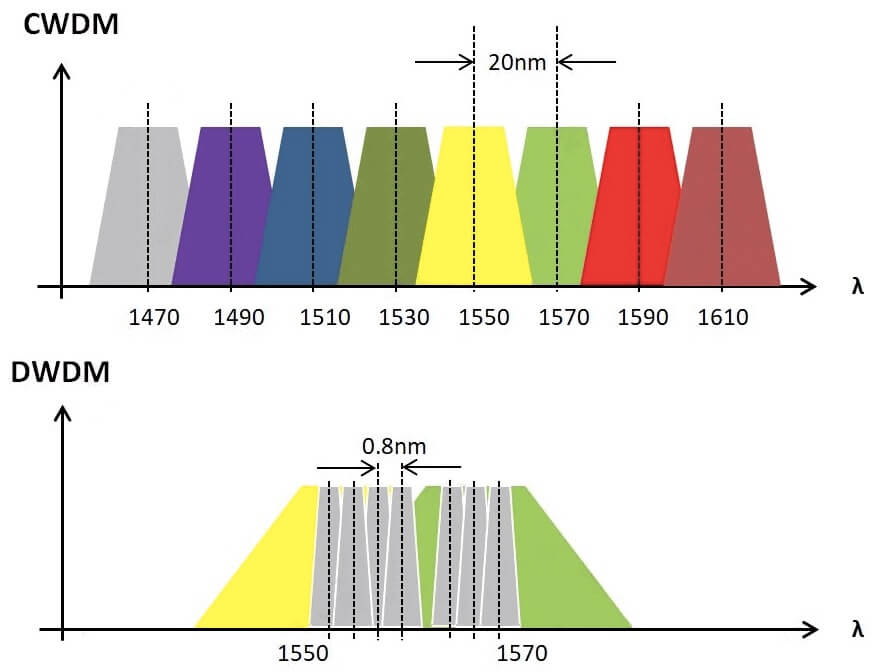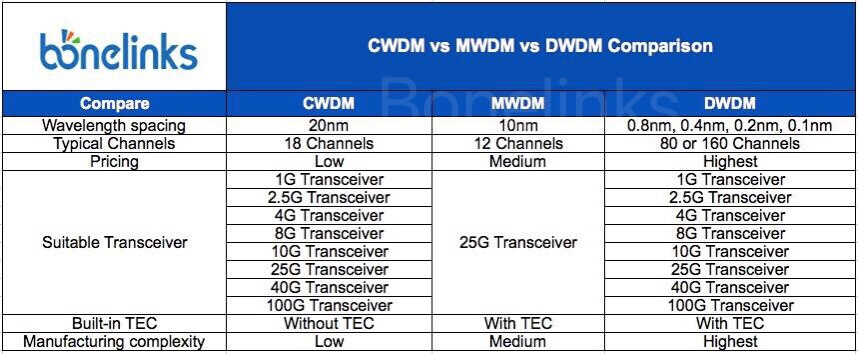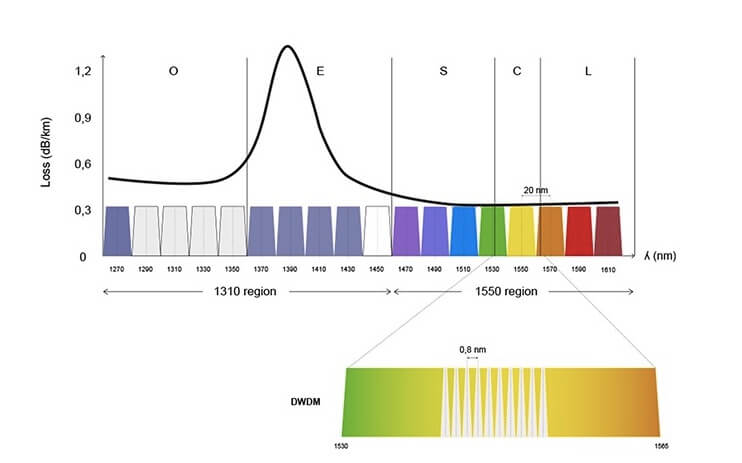The expansion of 5G infrastructure on a large scale is increasing the requirements for the underlying network. The 5G bearer network primarily consists of two parts: the 5G fronthaul network and the 5G backhaul network. Among these, Wavelength Division Multiplexing (WDM) technology is the favored choice for 5G fronthaul networks. Based on the specific wavelengths employed, WDM can be categorized into DWDM (Dense Wavelength Division Multiplexing), CWDM (Coarse Wavelength Division Multiplexing), the newly introduced MWDM (Medium Wavelength Division Multiplexing), and LWDM (Long Wavelength Division Multiplexing).
This article aims to delve into MWDM technology, offering insights into its origins, practical applications, and distinctions from other WDM technologies. Whether you’re new to optical communications or seeking more information, this guide is designed to provide you with a clear understanding of MWDM technology.
Why Metro Wave Division Multiplexing (MWDM) is Proposed?
In order to grasp the concept of MWDM, it’s important to delve into the reasons that led to its proposal.
The demands of 5G fronthaul networks are characterized by the need for high reliability, top-notch performance, cost-effectiveness, and simplified deployment solutions. There’s a call for a solution that is not only economically viable but also rapidly adaptable to dynamic market requirements. Chinese telecom operators introduced an inventive notion known as 12-wave multiplexing WDM. MWDM is essentially built upon the foundation of well-established CWDM technology.
CWDM incorporates 18 wavelengths spanning from 1271nm to 1611nm. However, due to the higher attenuation in the 1270nm to 1470nm range and cost considerations, only 6 wavelengths (1271nm, 1291nm, 1311nm, 1351nm, 1371nm) are typically used. MWDM capitalizes on these 6 CWDM wavelengths and ingeniously shifts them 3.5nm left and right, thereby expanding to a total of 12 waves (1267.5nm, 1274.5nm, 1287.5nm, 1294.5nm, 1307.5nm, 1314.5nm, 1327.5nm, 1334.5nm, 1347.5nm, 1354.5nm, 1367.5nm, 1374.5nm).
The core idea behind MWDM lies in repurposing the initial 6 CWDM wavelengths, compressing the 20nm interval between them to a mere 10nm. To achieve this, the technology employs TEC (Thermal Electronic Cooler) temperature control techniques to minimize wavelength deviations, effectively doubling the count of CWDM wavelength channels. The result is an enhanced bandwidth capacity that contributes to efficient utilization of fiber resources.
What is Metro Wave Division Multiplexing (MWDM)?
MWDM stands for Metro Wave Division Multiplexing, a technology introduced and strongly advocated by China Mobile in recent years. This innovative approach involves medium wavelength division multiplexing, aiming to enhance the number of wavelength channels within the same parameters. This is achieved by reducing the wavelength spacing of CWDM from 20nm to 10nm. However, this narrower spacing necessitates a more stable laser to prevent interference between adjacent wavelengths. The laser’s wavelength shift must remain below 3.5nm to avoid these “collisions.”
DWDM channels are packed more closely together than those in CWDM. They make use of specific wavelength ranges known as C-band (1525nm-1565nm) and L-band (1570nm-1610nm). These ranges are extracted from within the broader CWDM wavelength spectrum. Unlike CWDM, where the spacing between channels is 20nm, DWDM offers much smaller spacing options of 0.4nm, 0.8nm, 1.6nm, and so on. This tighter spacing requires the use of additional wavelength control devices.

The primary purpose behind Metro Wave Division Multiplexing (MWDM) is to address the pressing requirements of 5G commercialization. It achieves this by making adjustments to the parameters based on the well-established CWDM technology. This strategic alignment allows the industry to leverage the existing CWDM module production processes, enabling a swift response from the industry chain to meet the demands of the market.
CWDM vs. MWDM vs. DWDM, What is the Difference?
The differences between CWDM, MWDM, and DWDM mainly lie in wavelength spacing, channel capacity, and cost. MWDM stands out as a superior choice between and DWDM. MWDM effectively balances the number of wavelength channels with cost considerations, making it a more favorable option.

What is the Advantage of Metro Wave Division Multiplexing (MWDM)?
Optimal Fiber Resource Utilization
MWDM builds upon CWDM technology, effectively doubling the number of wavelength channels while decreasing the wavelength spacing from 20nm to 10nm. This innovation enables the transmission of 8 to 16 channels through a pair of single-mode fibers (SMF), leading to significant cost savings in fiber deployment.
Cost Reduction
MWDM leverages established CWDM Mux/Demux devices, OADMs, and other components available at competitive prices in the market. This approach contributes to cost-effective implementation.
Streamlined Network Architecture and Enhanced Management Efficiency
MWDM technology allows the multiplexing of various services onto a single wavelength channel. This consolidation reduces the need for multiple devices, cables, and patch panels. Additionally, it enhances service flexibility by simplifying the addition or removal of services.
Scalability and Expandability
The MWDM system offers the capability to expand the network according to its evolving needs. With MWDM Mux/Demux devices, new wavelength channels can be added or multiplexed without necessitating changes to other components in the system.
Seamless Integration with Existing Infrastructure
MWDM leverages the production processes and industrial chain established for CWDM, making it a practical solution to meet the urgent demands of 5G commercialization.
What is the Disadvantage of Metro Wave Division Multiplexing (MWDM)?
Power Consumption:DWDM systems harness cooling lasers for temperature tuning, optimizing performance, safety, and system lifespan. However, this advanced technology comes with a trade-off, consuming more power compared to the electronic tuning uncooled lasers in CWDM systems.
Conclusion
Discover the world of Metro Wave Division Multiplexing through this guide, designed to enhance your understanding of MWDM technology. As the market evolves, the emergence of 25G MWDM transceiver modules offers a promising solution for robust 5G front-haul and mid-haul applications, boasting both high-density and bandwidth capabilities. For those seeking MWDM 25G transceivers, explore further details at bonelinks.com.




